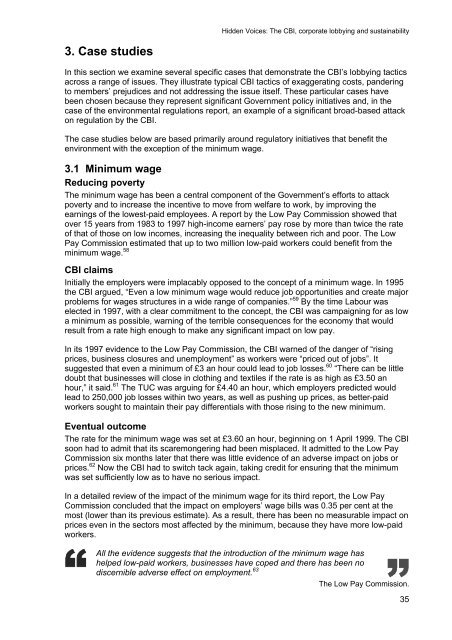hidden_voices
hidden_voices
hidden_voices
Create successful ePaper yourself
Turn your PDF publications into a flip-book with our unique Google optimized e-Paper software.
Hidden Voices: The CBI, corporate lobbying and sustainability3. Case studiesIn this section we examine several specific cases that demonstrate the CBI’s lobbying tacticsacross a range of issues. They illustrate typical CBI tactics of exaggerating costs, panderingto members’ prejudices and not addressing the issue itself. These particular cases havebeen chosen because they represent significant Government policy initiatives and, in thecase of the environmental regulations report, an example of a significant broad-based attackon regulation by the CBI.The case studies below are based primarily around regulatory initiatives that benefit theenvironment with the exception of the minimum wage.3.1 Minimum wageReducing povertyThe minimum wage has been a central component of the Government’s efforts to attackpoverty and to increase the incentive to move from welfare to work, by improving theearnings of the lowest-paid employees. A report by the Low Pay Commission showed thatover 15 years from 1983 to 1997 high-income earners’ pay rose by more than twice the rateof that of those on low incomes, increasing the inequality between rich and poor. The LowPay Commission estimated that up to two million low-paid workers could benefit from theminimum wage. 58CBI claimsInitially the employers were implacably opposed to the concept of a minimum wage. In 1995the CBI argued, “Even a low minimum wage would reduce job opportunities and create majorproblems for wages structures in a wide range of companies.” 59 By the time Labour waselected in 1997, with a clear commitment to the concept, the CBI was campaigning for as lowa minimum as possible, warning of the terrible consequences for the economy that wouldresult from a rate high enough to make any significant impact on low pay.In its 1997 evidence to the Low Pay Commission, the CBI warned of the danger of “risingprices, business closures and unemployment” as workers were “priced out of jobs”. Itsuggested that even a minimum of £3 an hour could lead to job losses. 60 “There can be littledoubt that businesses will close in clothing and textiles if the rate is as high as £3.50 anhour,” it said. 61 The TUC was arguing for £4.40 an hour, which employers predicted wouldlead to 250,000 job losses within two years, as well as pushing up prices, as better-paidworkers sought to maintain their pay differentials with those rising to the new minimum.Eventual outcomeThe rate for the minimum wage was set at £3.60 an hour, beginning on 1 April 1999. The CBIsoon had to admit that its scaremongering had been misplaced. It admitted to the Low PayCommission six months later that there was little evidence of an adverse impact on jobs orprices. 62 Now the CBI had to switch tack again, taking credit for ensuring that the minimumwas set sufficiently low as to have no serious impact.In a detailed review of the impact of the minimum wage for its third report, the Low PayCommission concluded that the impact on employers’ wage bills was 0.35 per cent at themost (lower than its previous estimate). As a result, there has been no measurable impact onprices even in the sectors most affected by the minimum, because they have more low-paidworkers.All the evidence suggests that the introduction of the minimum wage hashelped low-paid workers, businesses have coped and there has been nodiscernible adverse effect on employment. 63The Low Pay Commission.35


